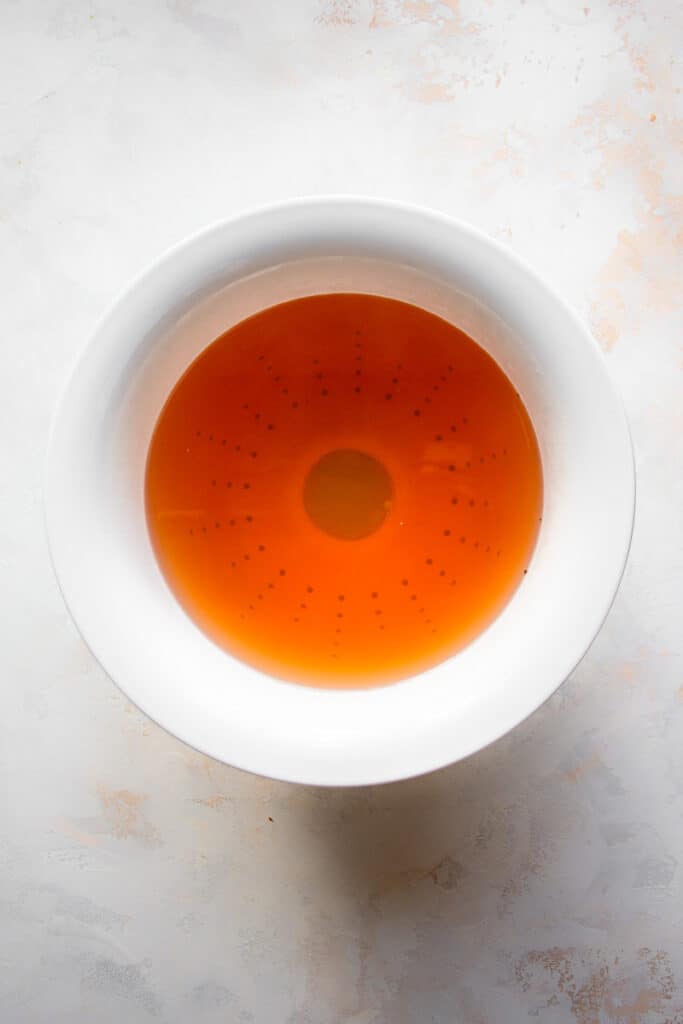Did you ever think about reusing your vegetable scraps instead of throwing them away? This vegetable broth from scraps is such a great way to use every single part of vegetables before discarding them. We'll tell you how to save vegetable scraps over time, how to make your own broth from scraps and when to use it!

Jump to:
Why we love vegetable broth made from scraps
- It's very cost-effective as you can make a flavorful broth without having to buy additional ingredients.
- It reduces waste in the sense that we try to use every single part of a vegetable (even if we end up discarding the scraps after we made the broth).
- It's a great way to add some flavor to grains (rice, pasta) and blended vegetable soups (no bouillon soups or ramen-type soups).
- It's easy to make if you're meal prepping and have large amounts of scraps at once.
Important side notes!
- This broth won't blow your mind and is not a replacement for qualitative vegetable broth. You don't want to use it in bouillon-based dishes (e.g., noodle soup, ramen) or to bind sauces. Use it to cook grains such as pasta and rice and make them a little more flavorful. You can also use it to reheat sauces (as you often need to add a splash of water or broth). We like to add to homemade vegetable soups that are already pretty flavorful and don't require super qualitative broth (e.g., red pepper and lentil soup, Moroccan pumpkin soup).
- The flavor is very much impacted by the scraps you saved. A broth made from onion, garlic, carrot and celery scraps in well-balanced proportions will be very tasty. However, an overabundance of certain veggies versus others can make the soup taste weird and sometimes even bitter. Make sure to avoid the veggies mentioned below.
- The intensity of vegetable stock made from scraps will be much weaker than regular stock.
- The broth will be darker as it's made mostly from scraps.
How to save vegetable scraps
- Wash the vegetables.
- Save any tips, root ends, skins and trims.
- Place them in a freezer bag. When you're done, close it and make sure it's air-tight.
- Store it in your freezer.
- The next time you cook and have some vegetable scraps, add them to the bag and place it back in the freezer.
You can freeze your vegetable scraps for up to 6 months in an air-tight zip bag.
Important note: if you already have a bag with frozen scraps in your freezer, only take it out once you're done preparing all the vegetables to prevent it from thawing. Add the new scraps to the zip bag and place it back in the freezer right away.
What scraps can I use to make vegetable stock?
Vegetables
- Celery: any trim, leaves and ends
- Carrots: peel, tips and ends
- Leeks: green tops and root ends
- Fennels: tops and ends
- Tomatoes: tops, seeds and evetually skins
- Mushrooms: stems, skins and trims
You can use vegetables that are a little wilted or not looking as fresh anymore. However, they should never be rotten or moldy.
Vegetables to avoid: broccoli, cauliflower, cabbage, brussels sprouts, asparagus, turnips and other vegetables that can make your broth bitter or overly sweet. Peppers and potatoes should be avoided, as well.
Herbs and aromatics
- Onion and shallots: skins, tips and ends
- Garlic: any trims and skins
- Parsley, thyme, basil: stems and dry leaves
- Ginger: peel and the fibrous parts when grated
Elo's tips
- Use organic vegetables when possible.
- Wash your vegetables and make sure the scraps are free of dirt and mold. Discard any parts where dirt doesn't come off with water or that is moldy (pay particular attention to onion skins).
- Add seasoning and spices to the broth, such as salt, peppercorns, a bay leaf, juniper berries, fennel seeds or mustard seeds.
- Sauté the vegetables. Depending on the vegetables you are using, you may want to roast them in a little oil for a few minutes before pouring in the water. Roasting caramelizes the residual sugar and will lead to a milder flavor.
Step-by-step with pictures
Save your vegetable scraps when cooking. Always start by washing your vegetables. Save any tips, trims and ends that you would normally discard.
You'll need 4 cups of vegetable scraps for 8 cups of water.
If you have about four cups of scraps you can proceed with making the broth right away. If not, place all the scraps in a freezer bag, close it and place it in your freezer (with the date written on it). Any time you're cooking, collect your vegetable scraps and add them to the freezer bag. Once you have about 4 cups of frozen scraps, you can make the broth.

Add everything to a pot. Add the vegetable scraps (no need to thaw them), any aromatics, herbs and spices (a bay leaf, some peppercorns and juniper berries) to a large stockpot and cover with cold water. You can either sauté them in a little bit of oil first or pour in the water right away.
Simmer the broth. Cover with a lid and simmer for 20 to 30 minutes. The longer you let the broth simmer, the more flavorful it will be (especially if using large amounts of water).
Strain the broth through a fine-mesh sieve. Discard the vegetables and transfer the broth to freezer-safe containers or zip bags.
How to store homemade vegetable broth
- Ladle the broth into clean, air-tight, freezer-safe containers. Let it cool down completely before your refrigerate or freeze it.
- Fill it into zip bags. Make sure to leave enough room at the top of the zip bag for the broth to expand as it freezes. Press out as much air as possible (or suck it out with a straw). Freeze the bags laying flat. Store as wanted once completely frozen.
- Pour it into large silcone ice cube trays. Once frozen, you can transfer the cubes to a zip bag or container. These are very practical to add to a sauce or to reheat saucy dishes.
You can store the broth for up to 5 days in the fridge or for 4 to 6 months in the freezer.
Don’t forget to join the Cooking With Elo newsletter. You’ll get gluten-free and vegan dinner ideas sent right to your inbox.
The recipe

Vegetable Broth From Scraps
Ingredients
- 4 cups (800 g) vegetable scraps see notes
- 8 cups (2 L) water
- 1 (1) bay leaf see notes
- ½ teaspoon (½ teaspoon) salt
Instructions
- Collect your vegetable scraps while cooking. If you don't have 4 cups of scraps right away, put the scraps you have in a freezer bag. Seal it and place it in your freezer. The next time you're cooking, add new scraps to the freezer bag. Repeat until you have about 4 cups.
- Add the frozen vegetable scraps to a stockpot. Optionally, sauté them in a little oil for several minutes. Cover with water. Add in the bay leaf, salt and other spices if using.
- Cover with a lid and simmer for 20 to 30 minutes.
- Strain the broth through a fine-mesh sieve. Transfer it to air-tight freezer-safe containers, zip bag or large silicone ice-cube trays (read tips in post above).
Notes
- Vegetable scraps to use: peels, tips, (rooty) ends and trims from celery, carrots, leeks, fennels, tomatoes and mushrooms. You can also use whole vegetables that are a little wilted or not looking as fresh anymore. However, they should never be rotten or mold.
- Other scraps to use: skins, tips and ends from onions and shallots, Trims and skins from garlic cloves. The stems and dry leaves from parsley, thyme and basil. The peel and fibrous parts of ginger.
- Vegetables to avoid: broccoli, cauliflower, cabbage, brussels sprouts, asparagus, turnips, peppers, potatoes and other vegetables that can make your broth bitter or overly sweet.
- Spices to add: peppercorns, a bay leaf, juniper berries, fennel seeds or mustard seeds.
- Storage tips: you can store the broth for up to 5 days in the fridge or for 4 to 6 months in the freezer.
Equipment
- Vegetable peeler
- Stockpot
- Strainer
Leave a star rating and review below. Thank you!
Join the 3-week soup challenge! Sign up here to get 3 soup recipes, grocery lists and bonuses sent to your inbox during the next 3 weeks! This challenge is a great way to get back into a routine and start meal prepping. You'll discover 9 nutritious, filling and delicious soups to make for yourself or your family.
Loved it? Please rate it!
If you tried this recipe or any other recipe from the blog, make sure to let me know how you liked it by leaving a star rating and a comment below. Your feedback really matters! To never miss a recipe, follow me on Instragram, Pinterest and Facebook.













Did you like this recipe? Let me know!